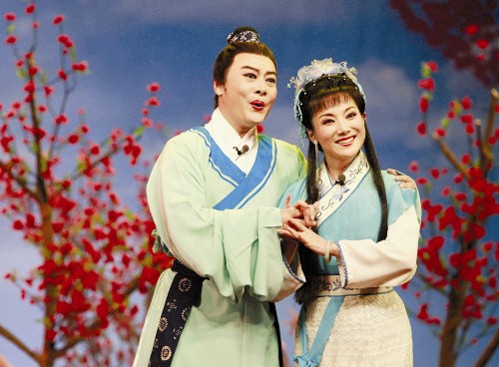Huangmei Opera
- Source: Hubei Provincial People's Government
- 08/18/2022 15:31
- 0 317

China Intangible Cultural Heritage
Year: 2006
Sort: Traditional Opera
Area: Anhui, Hubei
Serial No.: IV-60
Declarer: Anqing City in Anhui Province, Huangmei County in Hubei Province
Once called the "Huangmei Tune" or the "Caicha Opera", the Huangmei Opera is one of the most famous traditional operas in China.
As a local drama in East China's Anhui Province, Huangmei Opera actually originated in Huangmei County, Hubei Province, during the 18th century when Chinese local operas were flourishing.
After being introduced to Anhui Province, Huangmei Opera swiftly took off in Anqing City and many other neighboring provinces. Now, the opera has grown into a professional performance art in both rural and urban areas, becoming a recreational activity for millions of people and is especially popular in Anqing City, Anhui Province and Huangmei County in Hubei Province.
Ⅰ. Origin and Development
The Huangmei Opera was derived from the "Caicha Tune", folk ditties people sang while picking tea. It is a combination of local folk songs, dances and some widespread ancient operas. Bordering on Anhui Province, Huangmei County in Hubei Province is famous for its tea and tea-picking songs. It is also where Huangmei Opera got its original name of "Caicha Opera" ("tea-picking opera").
Before 1949, rivers and lakes in Anhui Province were often flooded and the displaced victims had to seek refuge in neighboring provinces. As a result, Huangmei Opera of Hubei Province was brought to Anhui by the victims of flood and famine.
From the time that Huangmei Opera became popular in rural areas, it had gone a long way from its status as a recreational activity to professional performances in big cities. It began as a diversion acted by and for peasants and artisans at festivals and special solar periods (the 24 weather-oriented divisions of the year).
As time went by, seasonal, semi-professional groups appeared, and they performed together with troupes that specialized in more popular forms of the art, like the Beijing Opera and Anhui Opera. It was not until 1926 -- 140 years after its advent -- that Huangmei Opera managed to reach Anqing, then the capital of Anhui Province. It appeared in Shanghai in 1934, but only on makeshift stages in the city's poor quarters.
Since 1949, with support from the Chinese government, Huangmei Opera has blossomed. In the early years, most Huangmei Opera plays were based on Chinese traditional folk tales. But as the opera flourished, more and more stories from other opera genres were incorporated.
Nowadays, Huangmei Opera is mainly popular in Anhui, Jiangxi and Hubei provinces, and some of its famous actors and actresses include Yan Fengying, Wang Shaofang and Pan Jingli. The opera has also spread its fame both at home and abroad with its sweet melodies and lyrics, graceful sounds and movements, and beautiful costumes and sets.
Huangmei fans can be found not only on the Chinese mainland but also in Hong Kong, Macao, Taiwan, Malaysia, Japan, and even Europe.
Ⅱ. Characteristics
Huangmei Opera costumes contain a distinctive local taste of China's ancient past. In most operas, artists wear ancient-style garments since most Huangmei operas are based on Chinese folk tales. Since the contents of the opera are often varied, costumes and sets change according to the opera's social environment and customs. In modern Huangmei operas, artists simply wear ordinary clothes when performing the modern play.
Huangmei Opera music features folk songs that are graceful and sweet-sounding. Three types of music are used: coloratura, character songs and basic tunes. The 104 coloratura tunes are taken from folk songs, tea-picking songs and other ditties. The Huangmei Opera music is light and lyrical. Singing is not only the main approach to characterization; it also distinguishes Huangmei Opera both stylistically and musically.
Huangmei Opera is easy to understand and learn thanks to its lyrical tunes, simple words and literary tradition. Like other Chinese local operas, Huangmei Opera also adopts the local dialect. Since the language is a mixture of northern and southern styles, it is therefore easy to imitate and pleasant to native ears. (This factor also helped spread Huangmei Opera.) Its local flavor and folk style are most vividly revealed in its original and lively dialogue, which is both spoken and sung.
Passion, simplicity and purity is what makes Huangmei Opera an enduring drama appreciated by all.
Ⅲ. Repertoires
Over the past 200 years, Huangmei Opera has developed quite a number of repertoires much loved by the people.
In particular, Anhui Provincial Huangmei Opera Troupe's "The Heavenly Maid and the Mortal" ushered in a new era for the opera in its development history. Although the play was a traditional favorite, the troupe revised the script, music and make-up.